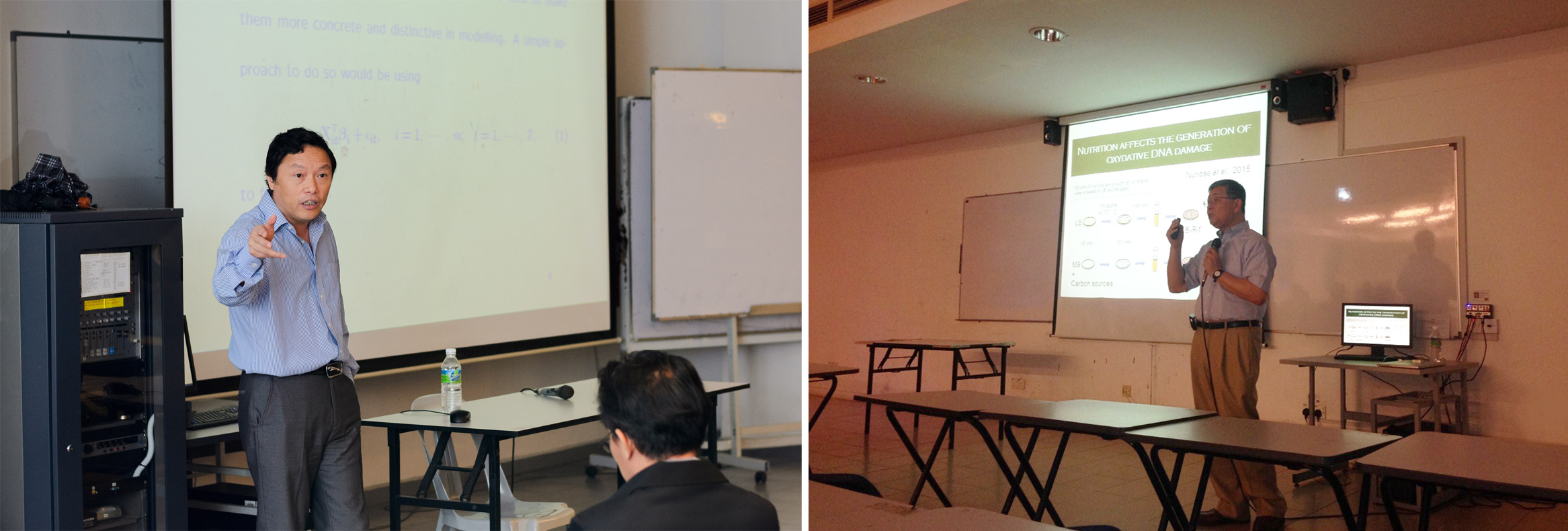

From left: Prof Zhang and Prof Maki explaining their researches
Aimed at enriching students’ scientific knowledge and equipping them with the latest research information, two separate scientific talks were organised by the Faculty of Science (FSc) at Kampar Campus.
The talk, held on 26 October 2018, was titled “Homogeneity Pursuit in Single Index Models based Panel Data Analysis”, and was conducted by invited speaker and external examiner for Bachelor of Science (Hons) Statistical Computing and Operations Research Prof Dr Wenyang Zhang from University of York, United Kingdom (UK). Also present at the talk were Head of Physical and Mathematical Sciences Department Dr Lam Weng Hoe, staff and students.
The objective of the talk was to inform participants of the cutting-edge methodology used in multi-source or panel data analysis. It was also aimed to enable participants to learn of this most advanced methodology for big data analysis and then apply it in their research or teaching.
The participants also benefitted from the talk when Prof Zhang presented the new modelling approach. According to Prof Zhang, the new modelling approach is based on the single index models embedded with homogeneity for panel data analysis, which builds the individual attributes in the model and is parsimonious at the same time compared to the traditional panel data analysis where all individuals are assumed to share the same unknown parameters, and only made sense if the main interests of the researchers are on global trend. Hence, the traditional method is unable to tell the researchers anything about the important individual attributes.
He also discussed a data-driven approach that is used to identify the structure of homogeneity, and estimate the unknown parameters and functions based on the identified structure. He also presented the asymptotic properties of the resulting estimators and showed intensive simulation studies to explain how well the resulting estimators work when the sample size is finite. He mentioned that the proposed modelling idea is currently useful in the application of public financial dataset and UK climate dataset.
The second scientific talk, held on 30 October 2018, saw invited speaker and external examiner for Bachelor of Science (Hons) Biotechnology Prof Dr Hisaji Maki from Nara Institute of Science and Technology, Japan speaking on “Cellular level of oxidative DNA damages varies with different nutritional conditions and oxygen concentrations in Escherichia coli”. Also present at the talk were FSc Deputy Dean Dr Sit Nam Weng, Head of Biological Science Department Dr Nor Ismaliza binti Mohd Ismail, staff and participants.
The objective of the talk was to provide participants with information on the effects of environmental factors for the growth of Escherichia coli (E.coli) on spontaneous mutagenesis and chromosomal rearrangements. It also aimed to provide participants with insights on the research development of DNA damage in E.coli. Prof Maki presented data that indicated that the spontaneous chromosomal rearrangements are caused by oxidative DNA damages in aerobically growing cells and readily affected by environmental factors such as nutrition and oxygen concentration.
From the research presented, participants understood that by analysing Rifr mutation frequencies in an E. coli strain, lacking MutM and MutY, repairs enzymes which suppress base substitution mutations caused by 8-oxoguanine in DNA. It appeared that the level of oxidative DNA damages was about nine-times and 63-times higher in cells grown in M9-glucose and M9-glycerol media, respectively, than in those in LB medium. It showed that about 14-times more oxidative DNA damages were produced in cells grown in LB medium in about 0.1% oxygen than in those in the atmosphere. However, Rifr mutation frequency in wild-type cells was unchanged in such different growth conditions, suggesting that the capacity of repair mechanisms for various oxidative damages are sufficient to suppress mutations caused by those damages even at very high levels. On the other hand, the frequency of spontaneous chromosomal rearrangements in wild-type E. coli cells varied with different growth conditions. When cells were grown in M9-glucose and M9-glycerol media, chromosomal rearrangement frequency was increased to about 4.2-times and 7.2-times, respectively, as high as that in LB medium. Likewise, the chromosomal rearrangement frequency was about 3.5-times higher in cells growing in the hypoxia condition than that in the atmosphere.
The scientific talks are part of FSc’s initiative to broaden the horizons of its staff and students so as to enrich their scientific knowledge.
© 2019 UNIVERSITI TUNKU ABDUL RAHMAN DU012(A).
Wholly owned by UTAR Education Foundation Co. No. 578227-M LEGAL STATEMENT TERM OF USAGE PRIVACY NOTICE